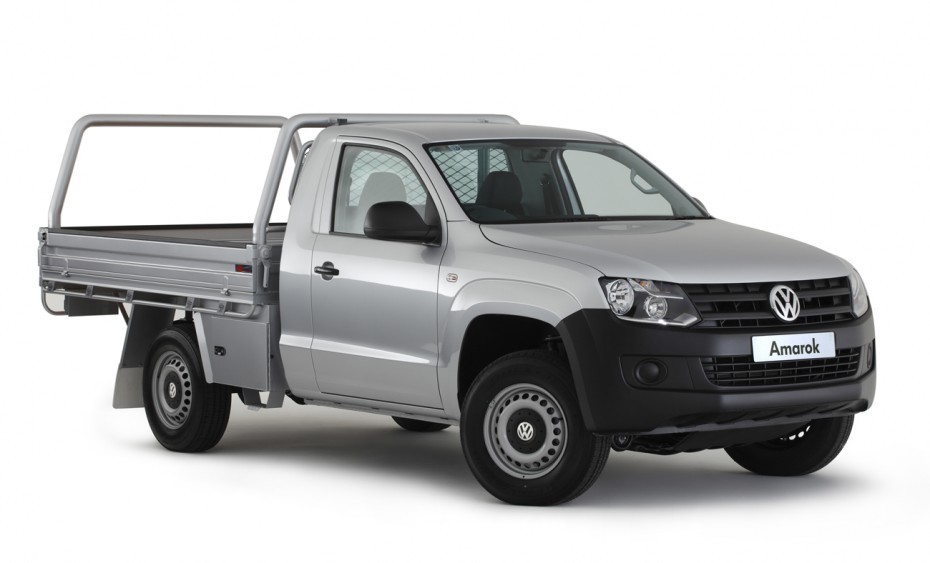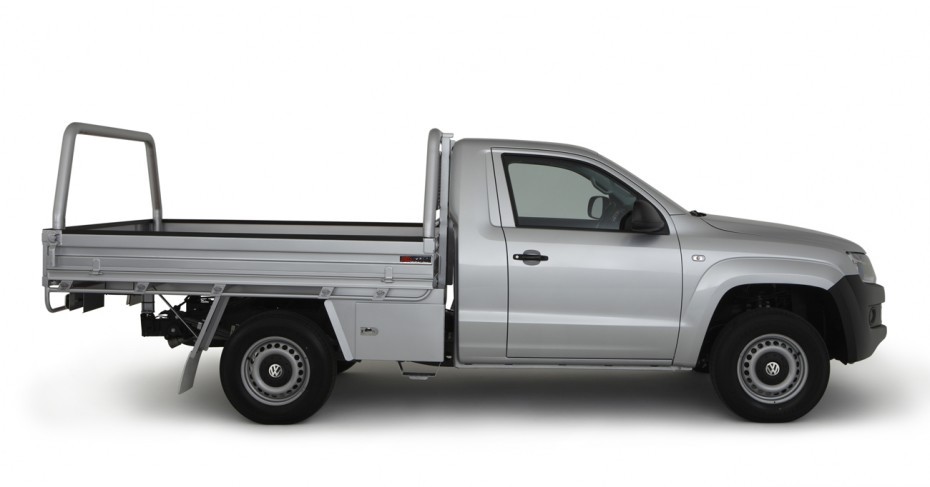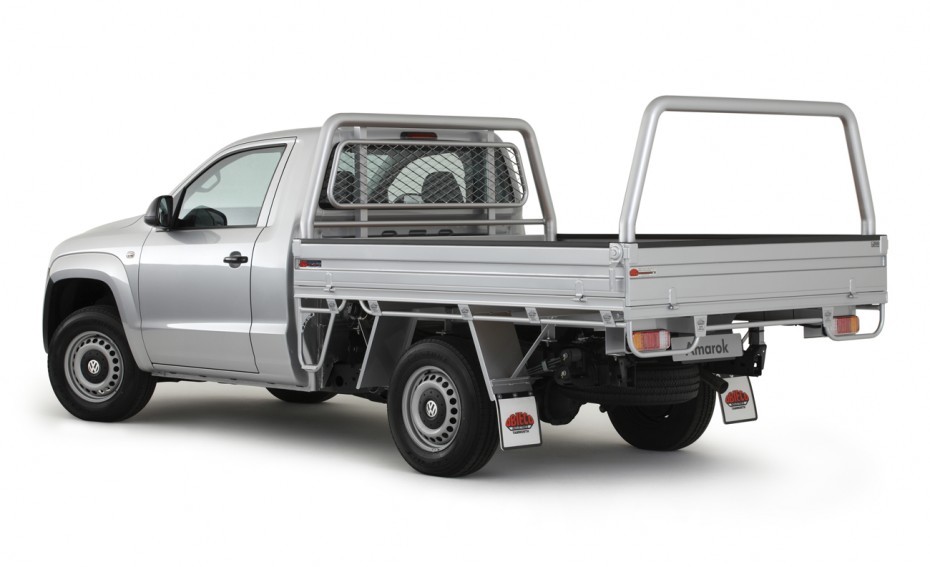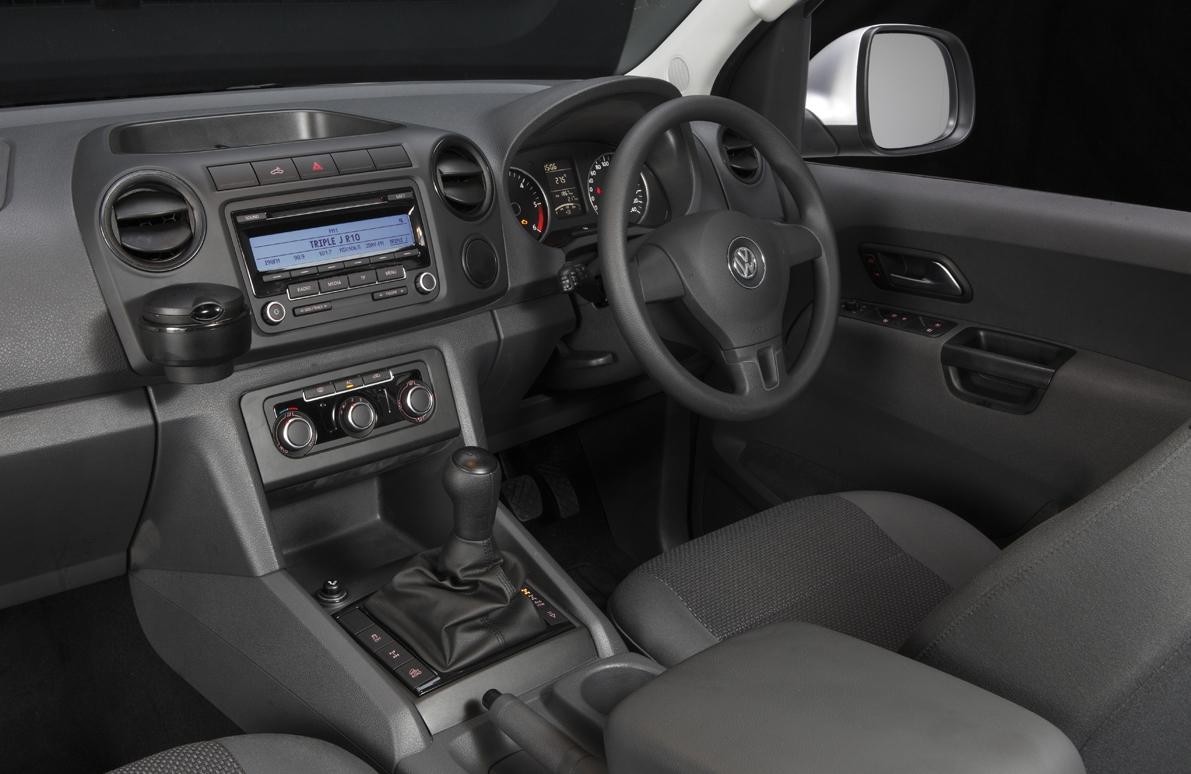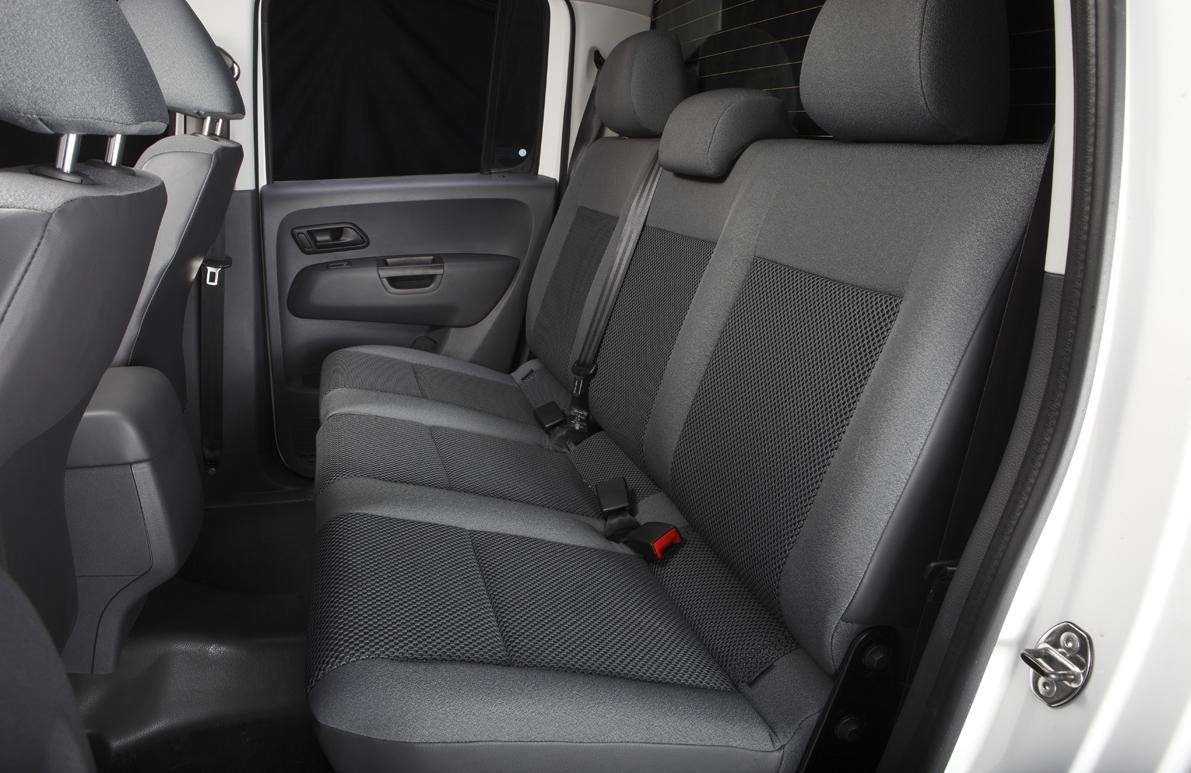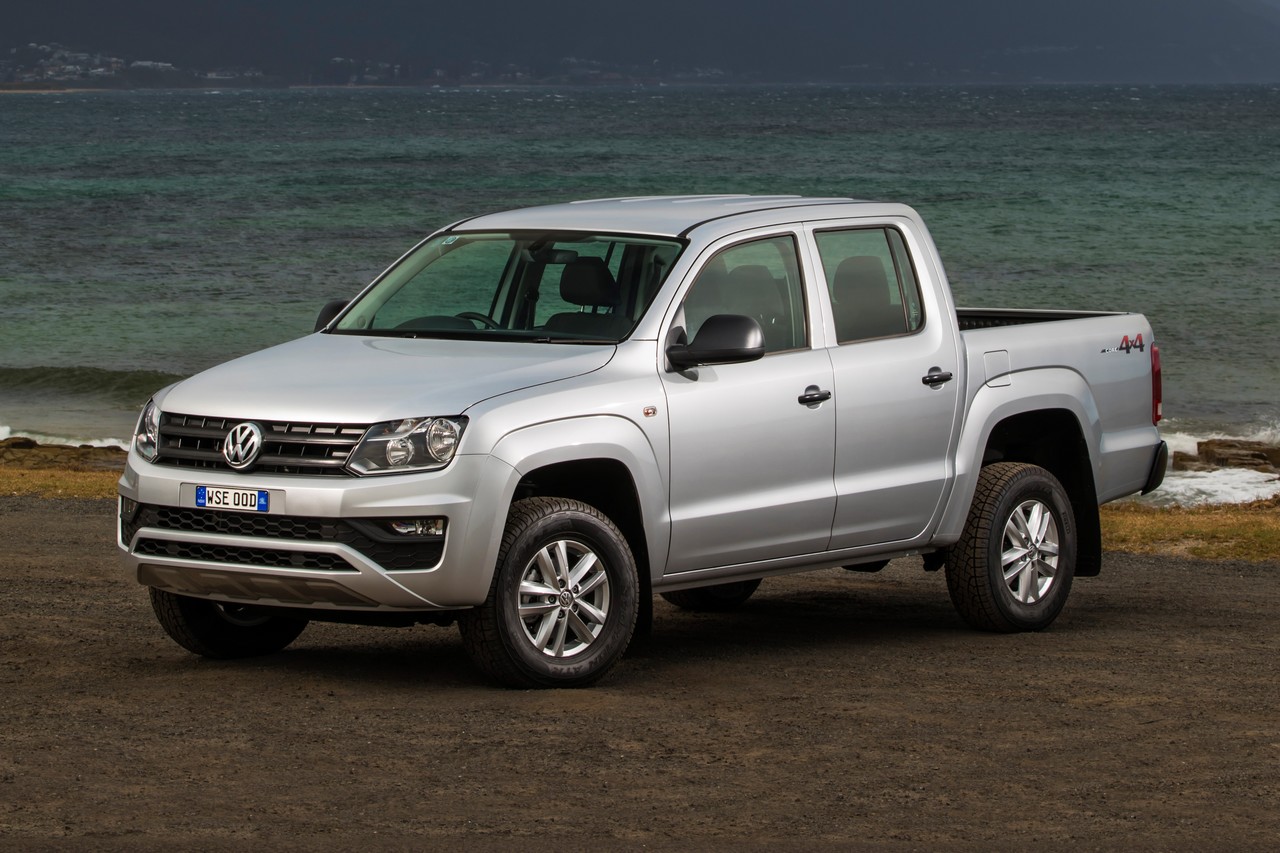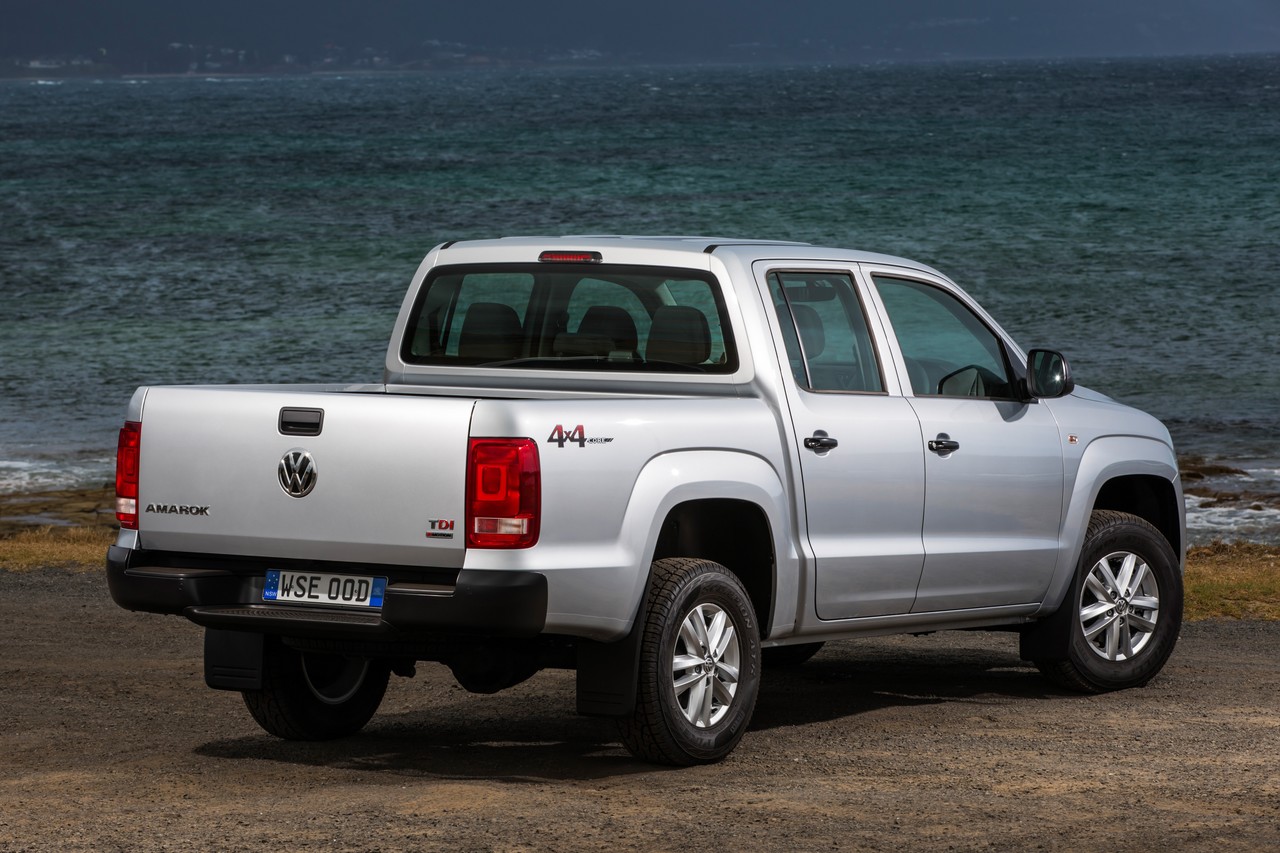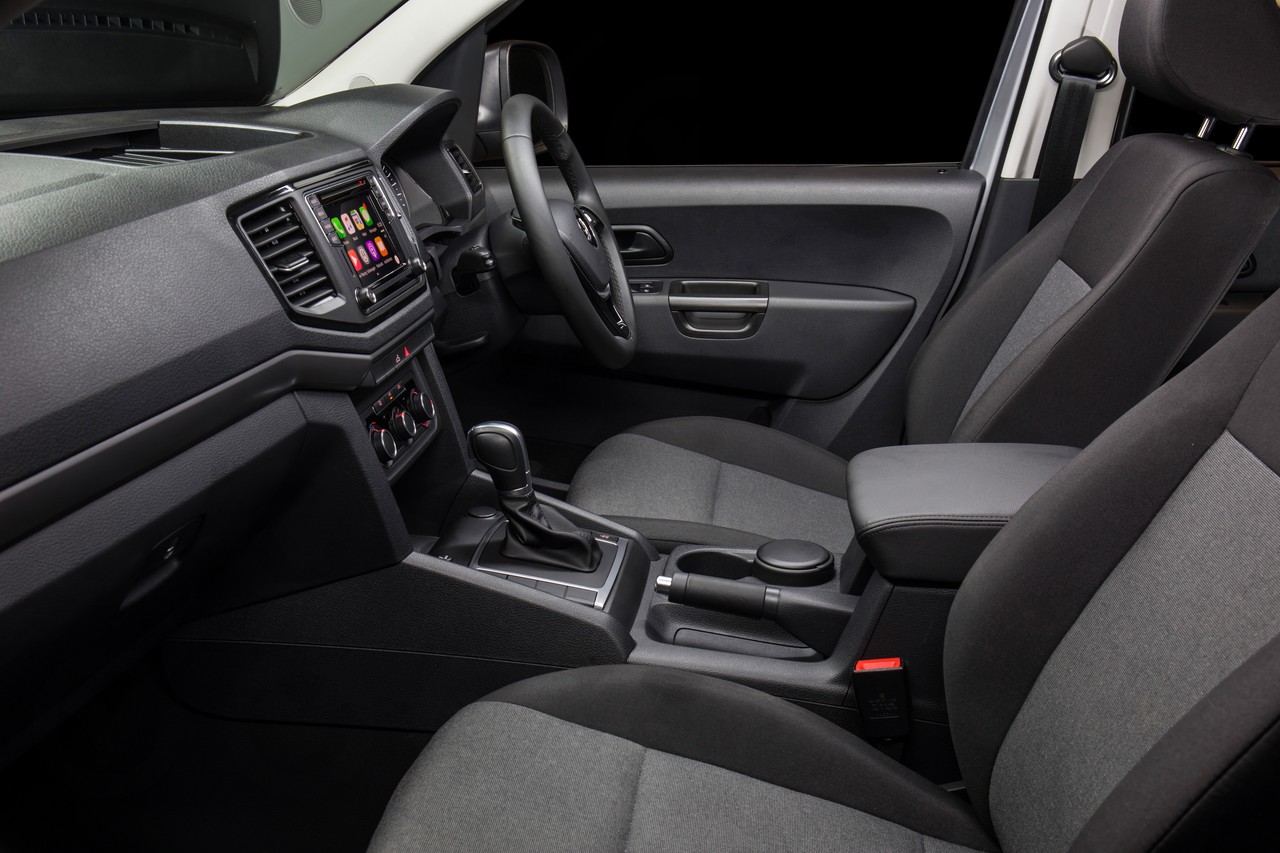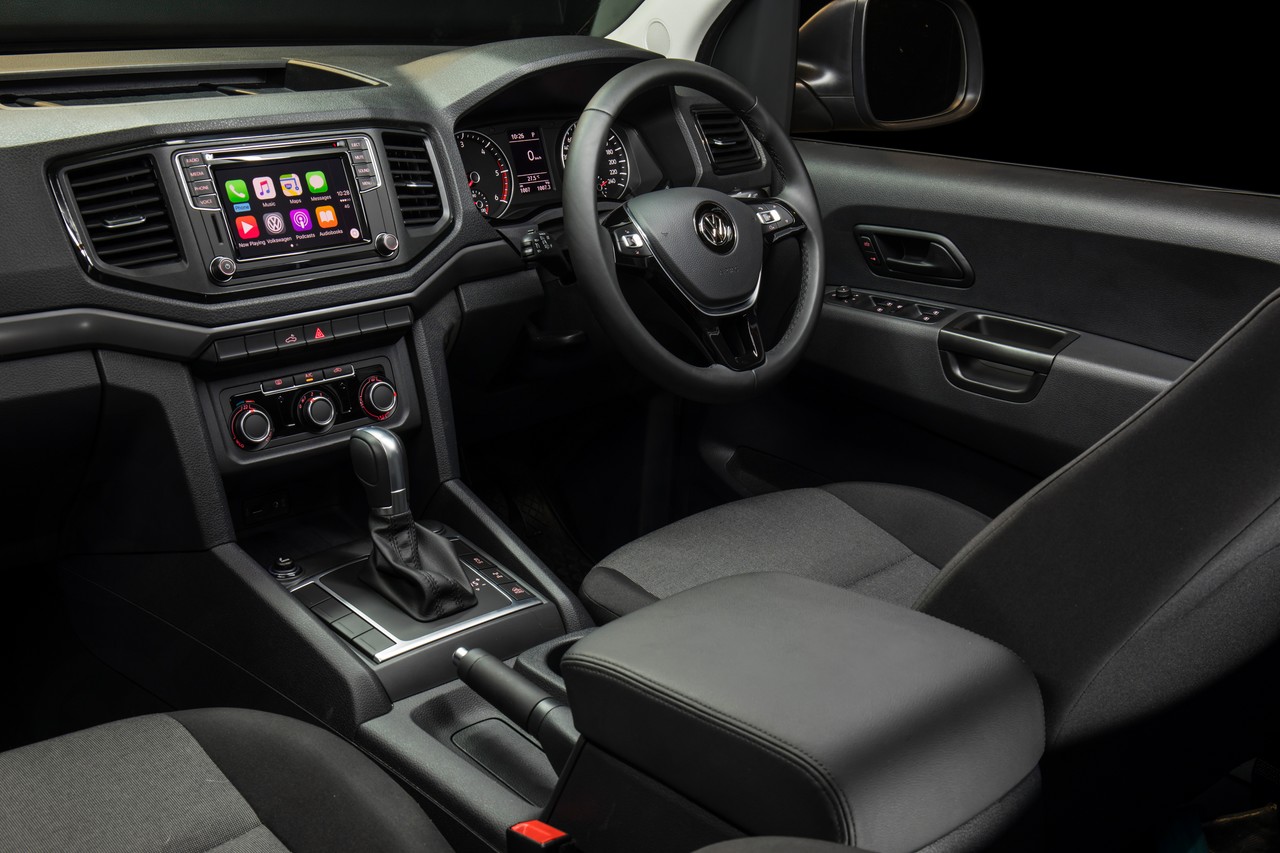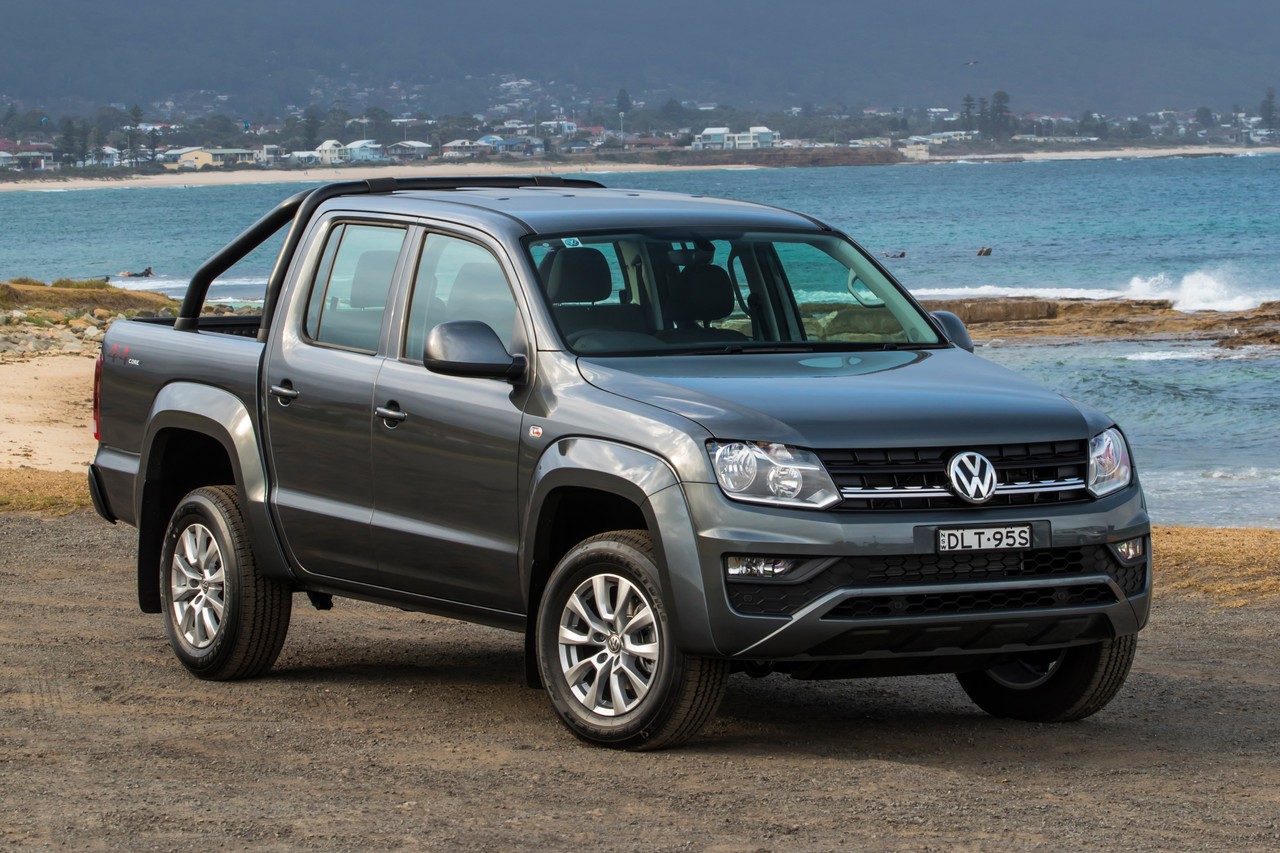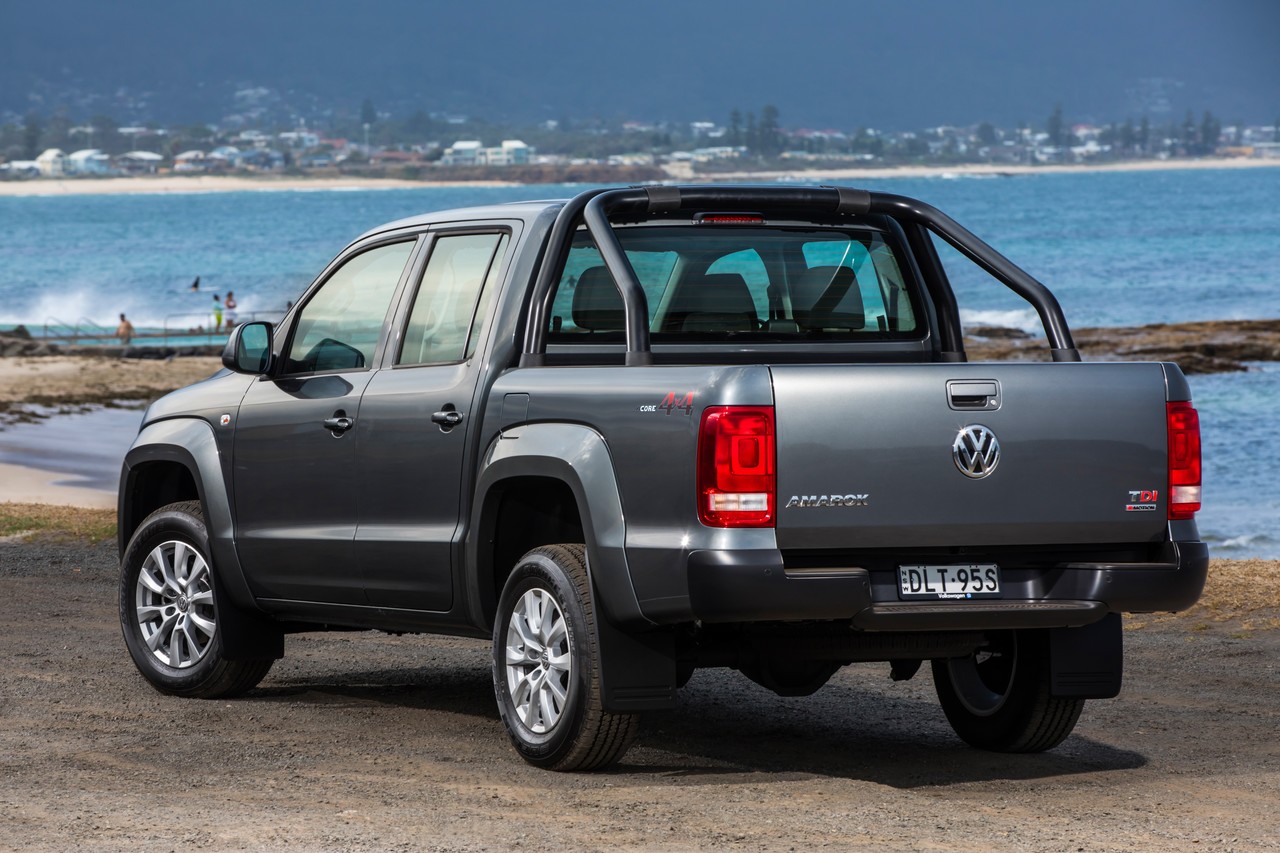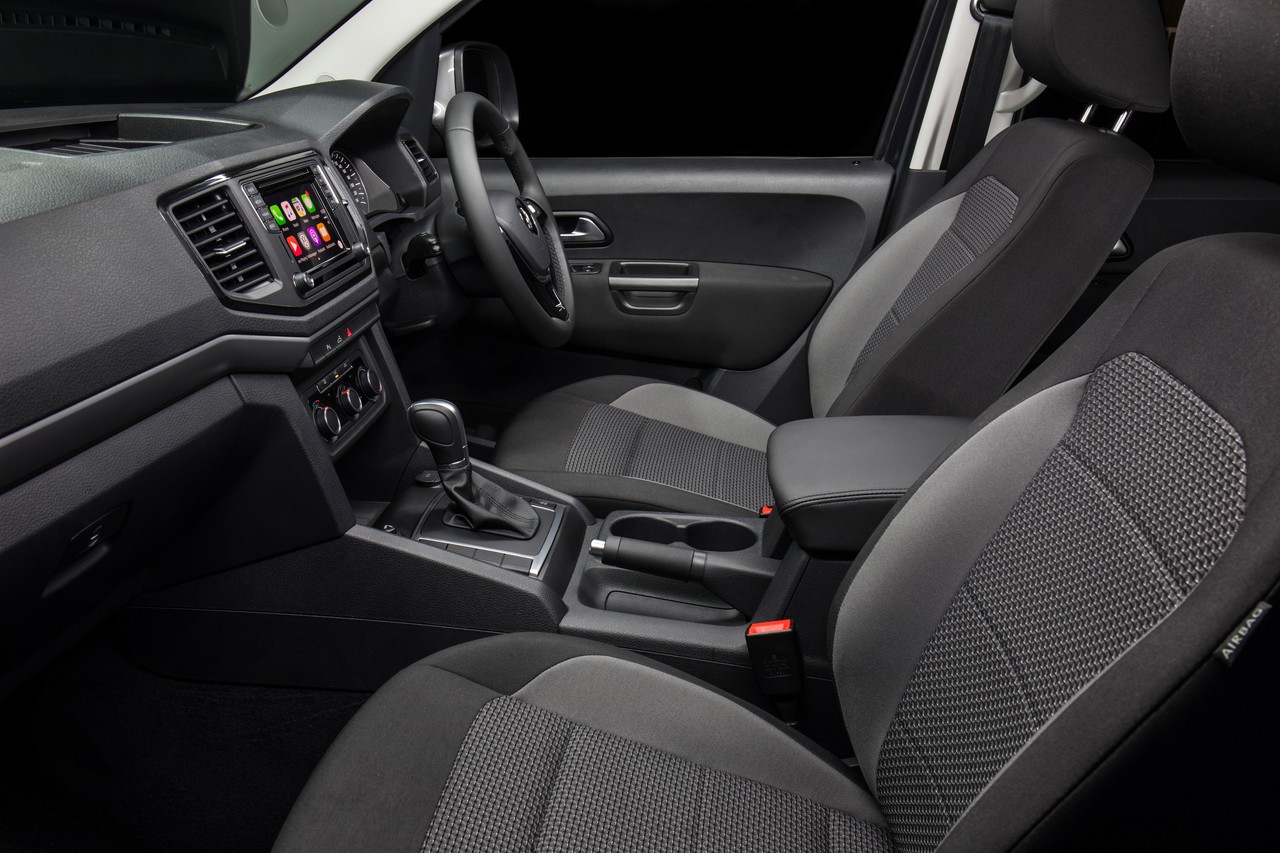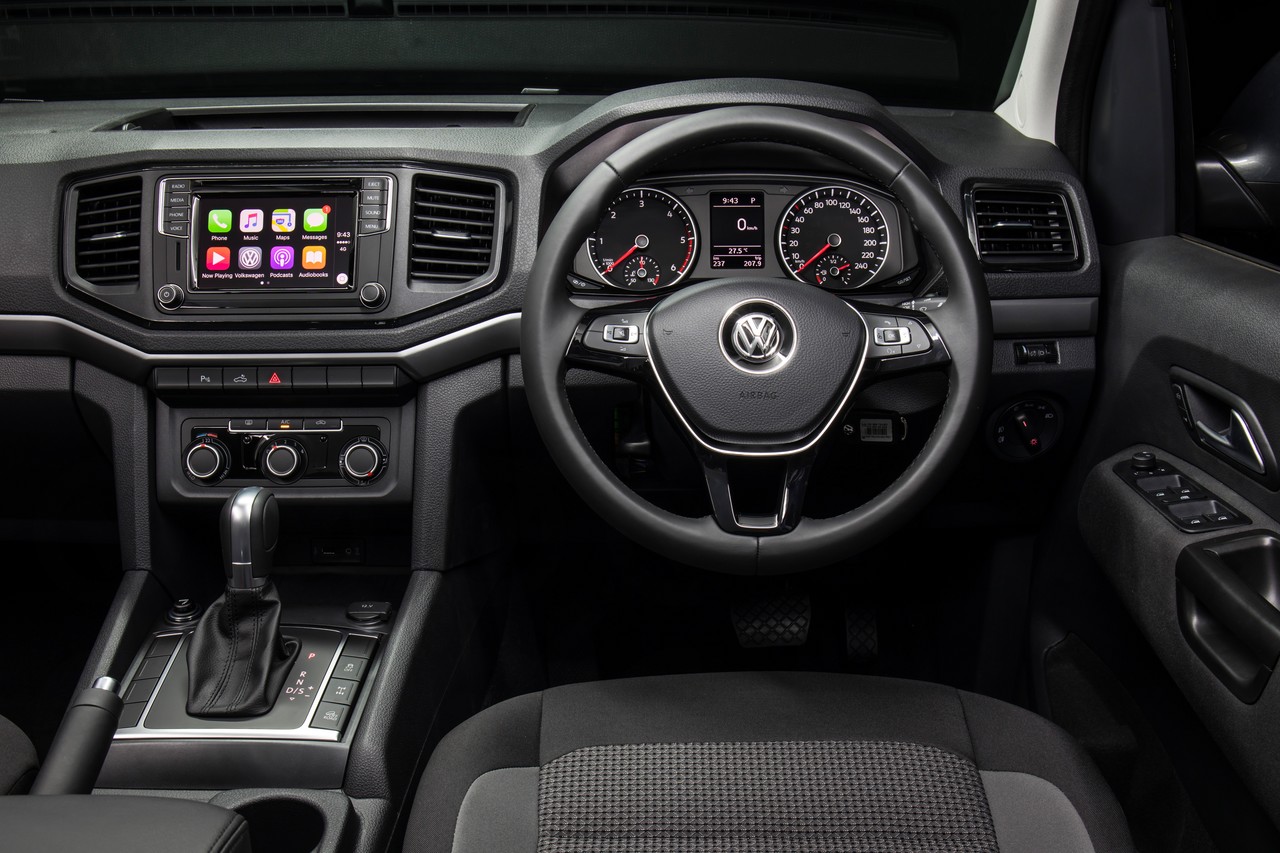
- Frugal and repsonsive turbo-diesel engines
- Refined eight-speed ZF automatic transmission
- Quiet, well-insulated cabin
- Comfortable front seats
- Excellent ride quality and good body control
- Accurate, well-weighted steering
- No rear airbag protection
- For manual transmission, clutch has agressive take-up over a narrow band
- Lacks towing capacity of rivals
Review: Volkswagen 2H.I Amarok cab chassis (2011-16)
Overview
Released in September 2011, the Volkswagen 2H Series I (2H.I) Amarok cab chassis was initially available as a four-door, dual-cab chassis. The Amarok cab chassis range consisted of the TSI300, TDI340 and TDI400 variants. The TSI300 was powered by a 2.0-litre turbocharged petrol engine, the TDI340 had a 2.0-litre turbo-diesel engine and the TDI400 had a 2.0-litre bi-turbo diesel engine; a six-speed manual transmission was standard across the range. The TDI400 was available with a selectable four-wheel drive system and in a better-equipped Trendline edition.
In July 2012, the range was expanded with the introduction of single cab models and the dual cab TDI420. The full range is given in the table below.
| Body | Variant | Engine | Drive | Edition | Trans. | Years | Power | Torque |
|---|---|---|---|---|---|---|---|---|
| Single cab |
TSI300 | 2.0-litre CFPA turbo petrol I4 | RWD | N/A | 6sp man. | 2012-14 | 118 kW at 3800 rpm-5500 rpm | 300 Nm at 1600 rpm |
| TDI340 | 2.0-litre CDBA turbo-diesel I4 | RWD | N/A | 6sp man. | 2012-14 | 90 kW at 3850 rpm | 340 Nm at 1750-2500 rpm | |
| TDI400 | 2.0-litre CDCA bi-turbo-diesel I4 | Selectable 4WD | N/A | 6sp man. | 2012-16 | 120 kW at 3750 rpm | 400 Nm at 1500-2500 rpm | |
| TDI420 | 2.0-litre CSHA bi-turbo-diesel I4 | Selectable 4WD | N/A | 8sp auto | 2014-16 | 132 kW at 4000 rpm | 420 Nm at 1750 rpm | |
| Dual cab |
TSI300 | 2.0-litre CFPA turbo petrol I4 | RWD | N/A | 6sp man. | 2012-14 | 118 kW at 3800 rpm-5500 rpm | 300 Nm at 1600 rpm |
| TDI340 | 2.0-litre CDBA turbo-diesel I4 | RWD | N/A | 6sp man. | 2012-16 | 90 kW at 3850 rpm | 340 Nm at 1750-2500 rpm | |
| TDI400 | 2.0-litre CDCA bi-turbo-diesel I4 | RWD, Selectable 4WD |
N/A | 6sp man. | 2012-14 | 120 kW at 3750 rpm | 400 Nm at 1500-2500 rpm | |
| 2.0-litre CDCA bi-turbo-diesel I4 | Selectable 4WD | Core | 6sp man. | 2014-16 | ||||
| Trendline | 6sp man. | 2012-16 | ||||||
| TDI420 | 2.0-litre CSHA bi-turbo-diesel I4 | Permanent 4WD | N/A | 8sp auto | 2012-14 | 132 kW at 4000 rpm | 420 Nm at 1750 rpm | |
| Core | 8sp auto | 2014-16 | ||||||
| Trendline | 8sp auto | 2012-16 |
Selectable and Permanent 4WD systems
The selectable 4WD (‘4Motion’) system featured a rear differential lock and switchable ‘2WD’, ‘4WD High’ and ‘4WD Low’ modes, the latter with a front/rear axle lock and 2.72:1 gear ratio.
The permanent 4WD (‘4XMotion’) system was shared with the Touareg and included a mechanical torque-sensing centre differential with a default front/rear torque split of 40:60, but up to 80 per cent of the engine’s torque could be directed to the rear axle if required. Models with automatic transmissions, however, did not have a low-range transfer case.
Safety equipment
Standard safety equipment for the Volkswagen Amarok cab chassis included dual front airbags, front seat-mounted side airbags with head and thorax protection, ABS, electronic brake force distribution, brake assist, electronic stability control, front seatbelts with pretensioners and load limiters, hill hold assist and hill descent control.
Euro NCAP testing
In Euro NCAP testing , a four-wheel drive dual cab VW 2H Amarok utility received a four star safety rating with an 86 per cent adult occupant protection rating and a 64 per cent child occupant protection rating. In the frontal offset impact test, protection from serious chest injury was marginal for the driver. While maximum points were awarded in the side impact test, chest protection was rated as poor in the pole test. Under ANCAP’s methodology , this testing resulted in a five star adult occupant protection rating with a score of 32.99 out of 37.
Features
Standard features for the VW Amarok cab chassis included 16-inch steel wheels, a two speaker sound system with CD player and MP3-compatibility, climate control air conditioning, ‘Spacer’ cloth trim, daytime running lights, split and folding rear seats, remote central locking, power windows and heated mirrors, height adjustable front seats, a rake and reach adjustable steering wheel and an immobiliser.
The Amarok Trendline was further equipped with 16-inch alloy wheels, a four speaker sound system, ‘Trail’ interior trim, cruise control, front fog lights, trip computer and a tray-mounted 12-volt outlet. Visually, the Trendline was distinguished by its body-coloured bumpers, door handles and mirrors; the matt-black rear bumper also enabled the tailgate to be lowered to a horizontal position.
July 2012: Amarok update
In July 2012, standard features for the 4WD models were extended to include cruise control, a multi-function leather-wrapped steering wheel and Bluetooth connectivity.
2013 Amarok TSI300 Runner edition (single cab)
In April 2013, ninety limited-run Amarok TSI300 single cab Runner editions were released. Compared to the standard Amarok, the Runner editions had alloy trays as standard, heavy-duty trim materials and could be identified by their ‘Runner’ badges.
November 2014 (MY15) update
In November 2014, the Amarok range was revised as the TSI300 variants were discontinued, new TDI420 models were introduced and the entry-level dual cab models became ‘Core’ Editions. As part of the update,
- Core Editions were fitted with 16-inch ‘Korama’ alloy wheels, Pirelli Scorpion ATR tyres and body-coloured bumpers; and,
- Trendline variants were further equipped with 17-inch alloy wheels and parking sensors (front and rear). Options were also extended to include the RNS315 satellite navigation system, reversing camera and adjustable front seat lumbar support.
Brochures
- Brochure: Volkswagen 2H Amarok (July 2012)
- Brochure: Volkswagen 2H Amarok MY13 (January 2013)
- Brochure: Volkswagen 2H Amarok MY14 (March 2014)
Specifications
- Specifications: Volkswagen 2H Amarok (February 2011)
- Specifications: Volkswagen 2H Amarok (September 2013)
- Specifications: Volkswagen 2H Amarok (January 2015)
Review: Volkswagen 2H.II Amarok cab chassis (2017-22)
Overview
The Volkswagen 2H Series II (2H.II) Amarok cab chassis was released in Australia in February 2017. Visually, the Volkswagen 2H.II Amarok cab chassis could be identified by its new upper grille with twin chrome bars, lower air intake with honeycomb-style mesh, slim fog lights and third brake light with LED technology. Inside, the 2H.II Amarok introduced a new dashboard panel which incorporated Volkswagen’s MIB infotainment system with touchscreen, radio and new technology including the option of navigation, Guide & Inform, Car-Net and App-Connect systems.
For Australia, the Volkswagen 2H.II Amarok cab chassis was solely available in a dual cab body.
| Variant | Edition | Engine | Trans. | Power | Torque |
|---|---|---|---|---|---|
| TDI400 4MOTION Selectable | Core, Core Plus |
2.0-litre CNEA biturbo diesel I4 | 6sp man. | 132 kW at 4000 rpm | 400 Nm at 1500-2250 rpm |
| TDI420 4×2 | N/A | 2.0-litre CSHA biturbo diesel I4 | 8sp auto | 132 kW at 4000 rpm | 420 Nm at 1750 rpm |
| TDI420 4MOTION Permanent | Core, Core Plus |
2.0-litre CSHA biturbo diesel I4 | 8sp auto | 132 kW at 4000 rpm | 420 Nm at 1750 rpm |
Safety equipment
Compared to the Volkswagen 2H.I Amarok cab chassis, standard safety equipment for the 2H.II Amarok utility was extended to include Volkswagen’s Multi-Collision Braking System. After a collision, Multi-Collision Brake would automatically apply the brakes to provide controlled deceleration – this made subsequent collisions less likely and reduced their potential severity. The system could be overridden, however, by the driver’s actions.
Brakes
The Volkswagen Amarok TDI400 and TDI420 had 303 mm by 28 mm ventilated front brake discs and 335.55 mm by 55 mm rear drum brakes.
Features: Volkswagen Amarok
As standard, the Volkswagen 2H.II Amarok dual cab included Volkswagen’s ‘Composition Media’ audio system with six speakers, a 6.33-inch colour touchscreen, CD player (MP3/WMA compatible), 3.5 mm auxiliary input, SD card and USB inputs, Volkswagen’s ‘App-Connect’ USB interface for smartphone integration (i.e. Apple CarPlay, Android Auto and MirrorLink), and Bluetooth mobile phone connectivity and audio streaming with voice recognition.
Beyond this, standard features for the Volkswagen Amarok included 6.5J x 16-inch steel wheels with 205 R16 tyres, ‘Austin’ seat trim, air conditioning, cruise control, halogen headlights, a rear fog lamp, a leather covered steering wheel and gearshift knob, 60/40 split folding rear seats, remote central locking, power adjustable and heated door mirrors, power windows, a height and reach adjustable steering wheel, a height adjustable driver’s seat, a 12 volt power socket in the centre console, rubber floor covering, shadow chrome-look dashboard inserts, a trip computer (Volkswagen’s ‘Multi-Function Display Plus’) and an immobiliser.
The Volkswagen Amarok was fitted with a full-size spare wheel as standard.
Features: Volkswagen Amarok Core
Compared to the standard Amarok, the Amarok Core added 6.5J x 16-inch ‘Korama’ alloy wheels with 245/70 R16 tyres, rear parking sensors, a rear view camera with static guidance lines and additional 12 volt power sockets (in the dashboard, second row centre console and cargo area). Visually, the Amarok Core could be identified by its matte black rear step bumper.
Features: Volkswagen Amarok Core Plus
Relative to the Amarok Core, the Amarok Core Plus featured 6.5J x 17-inch ‘Posadas’ alloy wheels with 245/65 R17 tyres, ‘Kemisu’ seat trim, front fog lights, front parking sensors, dusk-sensing headlights, rain-sensing wipers, carpet floor covering, storage under the front seats and a lockable glove compartment.
The Amarok Core Plus could be identified by its chrome radiator grille, body-coloured door handles and door mirror caps, extended wheel arch flares and matte black styling bar.
Specifications
Related links
